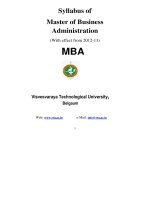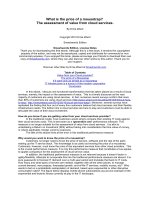Enterprise Guide to Gaining Business Value from Mobile Technologies..Enterprise Guide to Gaining ppt
Bạn đang xem bản rút gọn của tài liệu. Xem và tải ngay bản đầy đủ của tài liệu tại đây (10.79 MB, 338 trang )
237620 FM.qxd 3/24/04 4:13 PM Page i
Enterprise Guide to
Gaining Business
Value from Mobile
Technologies
237620 FM.qxd 3/24/04 4:13 PM Page ii
237620 FM.qxd 3/24/04 4:13 PM Page iii
Adam Kornak
Gaining Business
Jorn Teutloff
Michael Welin-Berger
Enterprise Guide to
Value from Mobile
Technologies
237620 FM.qxd 3/24/04 4:13 PM Page iv
Enterprise Guide to Gaining Business Value from Mobile Technologies
Published by:
Wiley Publishing, Inc.
111 River Street
Hoboken, NJ 07030-5774
www.wiley.com/compbooks
Published simultaneously in Canada
Copyright 2004 by Cap Gemini Ernst & Young U.S. LLC.
All rights reserved. No part of this publication may be reproduced, stored in a retrieval sys-
tem, or transmitted in any form or by any means, electronic, mechanical, photocopying,
recording, scanning, or otherwise, except as permitted under Section 107 or 108 of the 1976
United States Copyright Act, without either the prior written permission of the Publisher,
or authorization through payment of the appropriate per-copy fee to the Copyright Clear-
ance Center, 222 Rosewood Drive, Danvers, MA 01923, 978-750-8400, fax 978-646-8700, or
on the Web at www.copyright.com. You can contact the Publisher directly for permission
by email at or on the Web at www.wiley.com/about/
permission.
Wiley, the Wiley Publishing logo and related trade dress are trademarks or registered trade-
marks of Wiley Publishing, Inc. in the United States and other countries and may not be used
without written permission. All trademarks are the property of their respective owners.
Wiley Publishing, Inc. is not associated with any product or vendor mentioned in this book.
Limit of liability/disclaimer of warranty: while the publisher and author have used their
best efforts in preparing this book, they make no representations or warranties with respect
to the accuracy or completeness of the contents of this book and specifically disclaim any
implied warranties of merchantability or fitness for a particular purpose. No warranty may
be created or extended by sales representatives or written sales materials. The advice and
strategies contained herein may not be suitable for your situation. You should consult with
a professional where appropriate. Neither the publisher nor author shall be liable for any
loss of profit or any other commercial damages, including but not limited to special, inci-
dental, consequential, or other damages.
For general information on our other products and services or to obtain technical support
please contact our Customer Care Department within the U.S. at 800-762-2974, outside the
U.S. at 317-572-3993 or fax 317-572-4002.
Library of Congress Cataloging-in-Publication Data is available from the publisher.
ISBN: 0-471-23762-0
Manufactured in the United States of America
10987654321
Credits
Vice President and Publisher: Joseph B. Wikert
Executive Editor: Carol A. Long
Editorial Manager: Mary Beth Wakefield
Development Editor: Kezia Endsley
Production Editor: Felicia Robinson
Text Design & Composition: Wiley Composition Services
237620 FM.qxd 3/24/04 4:13 PM Page v
Contents
Acknowledgments xiii
About the Authors xv
Foreword xvii
Part 1 Introduction to Mobile and Wireless Technologies 1
Chapter 1 Wireless and Mobility Defined 3
Introduction 3
What Is Mobility? 4
What Are Wireless Applications? 6
Real-Time Quoting Engines 7
Location-Based Services 7
Wireless Portal/Commerce 7
Sales Force Automation (SFA) 8
Global Positioning Systems (GPS) 8
Telematics 8
Attributes of Mobility and Wireless Services 12
Always On 13
Remote Access 13
Localization 15
Ubiquity 15
Personalization 15
Proactive Push 16
Summary 17
Chapter 2 The Driving Forces of Mobile’s Growth 19
Introduction 19
Consumer Drivers 21
The Quest for Convenient Communication 22
Right Here, Right Now—Consumer Expectations 25
v
237620 FM.qxd 3/24/04 4:13 PM Page vi
vi Contents
The Device as a Personality Extension 26
Fun and Games 27
A New Channel for Existing Entertainment 29
New Types of Entertainment 30
Business Drivers 31
Cost Efficiencies 32
Wirelessly Enabled Employees 34
Reduced Traveling 34
Revenue Growth 41
Wireless as a Revenue Driver: m-Commerce 41
Process Improvement Opportunities 43
Enabling Technologies 44
Wireless Industry Trends 47
Summary 48
Chapter 3 Mobile Devices Showcase 49
Introduction 49
Merging Computers and Phones 50
Laptop Computers 51
Personal Digital Assistants (PDAs) 52
Palm Family (Palm OS) 53
Pocket PCs (Windows CE) 54
Two-Way Pagers 55
Cellular Phones 56
Smartphones 56
Imode Phones 57
Phones Using Java 58
Handheld Gaming Platforms 59
Future Devices 59
Summary 60
Chapter 4 Wireless Networks Overview 61
Introduction 61
The Generations of Wireless 62
First Generation: Analog 62
Second Generation: CDMA, TDMA, and GSM 63
CDMA 64
TDMA 65
GSM 66
2.5 Generation: GPRS, EDGE, and CDMA 2000 67
Third Generation: wCDMA, UMTS, and iMode 69
Fourth Generation Wireless—What’s Next? 69
WLANs and PANs 70
IEEE 802.11 70
Bluetooth 71
Infrared 73
Radio Frequency Identification 73
237620 FM.qxd 3/24/04 4:13 PM Page vii
Contents vii
Satellite and Fixed Wireless 74
Securing a Wireless Network 75
Wireless Equivalent Privacy 76
Summary 76
Part 2 Opportunity Identification and Case Studies 77
Chapter 5 The Value Web Framework 79
Introduction 79
Defining the Value Web Framework 79
What Is a Value Web? 80
The Web’s Anatomy 82
Why Use the Framework? 85
Constructing a Value Web 88
Step #1: Defining the Solution and Competitive Space 89
Step #2: Identifying and Evaluating Market Segments 90
Step #3: Mapping Customer Needs and Value Web
Constituents Along the Customer Experience Life Cycle
91
Identify 93
Research 93
Purchase 94
Receive 94
Support 95
Evaluate 95
Step #4: Defining Value Transactions 95
Leveraging the Value Web 97
Step #1: Analyzing Value and Sustainability to Define
Relative Power
97
Creating a Value Index 97
Assessing the Sustainability Index 102
Putting It All Together—The Power Grid 103
Step #2: Defining Strategic Focus Based on Power Shifts 104
Step #3: Developing Strategic Initiatives
and Quantifying Impacts
106
Summary 108
Chapter 6 The Wireless Value Web 109
Introduction 109
The Wireless Value Web’s Origin 110
Today’s Wireless Value Web 110
Taxonomy 111
Industry Segments 115
Customers/End-Users 116
User Devices 120
Content 123
Connectivity 128
Technology Enablers 131
Environmental Enablers 136
Summary 139
237620 FM.qxd 3/24/04 4:13 PM Page viii
viii Contents
Chapter 7 The Three Functional Domains 141
Introduction 141
Communication 142
Consumer Applications 143
Enterprise Processes 144
Information 145
Consumer Applications 145
Enterprise Processes 146
Information Available to Your Customers 146
Information Available to Your Employees 147
Commerce 147
Consumer Applications 148
Enterprise Processes 149
Enhanced Processes with Your Customers 149
Enhanced Processes with Your Employees 149
Summary 150
Chapter 8 Communication 151
Consumer Applications 151
Voice, E-mail, Paging, SMS/EMS, and Video 151
Voice 152
E-mail and Unified Messaging 153
Pagers and BlackBerrys 154
SMS/EMS/MMS 155
Video 155
Office Applications and Internet/Intranet Access 155
Office Applications 156
Internet/Intranet Access 156
Enterprise Processes 157
Voice, E-mail, Paging, SMS/EMS, Video 157
Filtering 158
Office Applications and Internet/Intranet Access 159
Summary 160
Chapter 9 Information 161
Consumer Applications 161
Sports, News, Weather, Maps, and Traffic 162
Sports 162
News 163
Weather 163
Maps 164
Traffic 164
Entertainment: E-books, Music, Gambling,
and Multiplayer Games
165
E-Books 165
Music 166
Gambling 167
237620 FM.qxd 3/24/04 4:13 PM Page ix
ix Contents
Multiplayer Games 168
Education 168
Emergency and Disaster Services 169
Enterprise Processes 170
News 170
Weather, Maps, and Traffic 170
Management Dashboard 171
Summary 173
Chapter 10 Commerce 175
Applications in Different Sectors 175
Communication with Your Clients 175
Advertising 176
Financial Services 178
Description of the Customer Value Proposition 178
Expected Technology Evolution 179
Phone-Based Applications Using SIM Cards 179
Browser-Based Applications for PDAs 180
Manufacturing 180
Telecom Sector 182
Media Sector 183
Retail Sector 184
Healthcare and Life Sciences Sectors 185
Energy and Utilities Organizations 186
Commerce and Enterprise Processes 187
Calculating Value Generated from Mobile Functionalities 190
Quantitative Benefits 191
Qualitative Benefits 191
Presenting the Benefits of Mobile Technologies 192
Field Service 193
Sales Force Automation 195
Telemetry: Remote Monitoring 199
Transportation 200
Dispatching and Routing 201
Summary 202
Chapter 11 Microsoft and CGE&Y Case Studies 203
Introduction 203
Wireless Field Service Automation 204
The Solution 205
The Process 206
Identify Work 207
Plan Work 207
Perform Work 208
Report Work 208
Follow up on Work and Create Invoice 209
237620 FM.qxd 3/24/04 4:13 PM Page x
x Contents
Part 3
Chapter 12
What’s the Business Value? 209
Quantitative Benefits 210
Qualitative Benefits 211
Wireless Commodity Exchange 212
Conceptual Business Scenario 214
Defining the Solution 216
Wireless Sales Force Automation 221
Conceptual Business Scenario 222
Defining the Solution 226
Mobile Management Information Dashboard 229
Conceptual Business Scenario 231
Defining the Solution 234
Mobile Financial Services Application 236
The Situation 237
The Solution 238
The Benefits 240
Streamlined Data Capture and Reporting 241
More Meaningful Business Intelligence 241
Improved Customer Service 241
Reduced Frequency of Errors 241
Robust, Easy-to-Use Development Platform 242
The Far-Reaching Possibilities 242
Summary 242
Strategy Formulation and Implementation
Methodology
243
Developing a Mobile/Wireless Solution 245
Introduction 245
Following a Structured Approach 246
Phase I: Mobile/Wireless Strategy Formulation 248
Stage 1: Developing a Vision 248
Formulation 249
Ownership 250
Communication 251
Stage 2: Setting the Direction 252
Internal Assessment 254
External Assessment 256
Value Web Analysis 258
Stage 3: Creating an Initiative Portfolio 259
Functionality Definition 259
Technology/Architectural Requirements 260
Cost-Benefit Analysis 260
Organizational Impact 260
High-Level Deployment Roadmap 261
Implementation Workplan 262
Alliance Approach 262
237620 FM.qxd 3/24/04 4:13 PM Page xi
xi Contents
Marketing Approach 264
Risk Mitigation 264
Creating the Proof of Concept 264
Functionality Refinement 266
User Experience Confirmation 266
Cost-Benefit Validation 267
Phase II: Strategy Implementation 267
Phase III: Strategy Monitoring 268
Summary 268
Chapter 13 Methodology for Building the Solution 271
Adaptive Technology Architecture
Definition (ATAD)
272
The Purpose of Architecture 276
Aspect Areas 277
Specialized Views 279
Levels of Contemplation 279
Logical Scenarios 284
Physical Scenarios 285
Migration Strategy 286
Security Strategy 286
Governance Strategy 287
Software Best Practices 288
Putting It All Together 289
Appendix A Industry Associations 291
Appendix B Useful URLs 295
Appendix C Glossary 301
Index 307
237620 FM.qxd 3/24/04 4:13 PM Page xii
237620 FM.qxd 3/24/04 4:13 PM Page xiii
Acknowledgments
There are a number of people we would like to thank, all of whom were
instrumental in bringing this book to our readers.
Microsoft
Microsoft’s Mobile Devices Division
The Microsoft EMSS team
The Legal team at Microsoft
The Scotia Bank team (and Scotia Bank) for allowing us to use the case
study
The Microsoft Financial Services Group and the VSU
Cap Gemini Ernst & Young
John Distefano
Brent Whitman and the Legal team
Marv Whitson and the Mobility Team
Hans Torin
Last but not least, we’d like to thank our families for their continued sup-
port during the many evenings and weekends that it took to write this book.
xiii
237620 FM.qxd 3/24/04 4:13 PM Page xiv
237620 FM.qxd 3/24/04 4:13 PM Page xv
About the Authors
Adam Kornak (Chicago, Illinois) is currently employed by Microsoft Cor-
poration and he specializes in mobility solutions and strategy for the finan-
cial services industry. He has over 14 years of experience in the field of
information technology and systems design. Adam has previously written
a number of books and articles and is the lead author of CGE&Y’s Guide to
Wireless Enterprise Application Architecture, published by John Wiley & Sons.
You can reach Adam at
Jorn Teutloff (Los Angeles, California) is President of JV-Global, LLC, a
professional services firm focusing on strategic business consulting, work-
force procurement, and outsourcing solutions. For over 8 years, he has led
project teams in the areas of strategic planning, business conceptualization,
and business-process reengineering at clients in various industries. Jorn is
a coauthor of CGE&Y’s Guide to Wireless Enterprise Application Architecture.
You can reach Jorn at
Michael Welin-Berger (Stockholm, Sweden) is mobile business director
at Cap Gemini Ernst & Young. With 4 years of experience with mobile solu-
tions and 12 years working with infrastructure and the Internet before that,
Michael Welin-Berger has extensive experience in demonstrating how to
benefit from new technologies. Michael is currently sharing his time
between Europe and the United States, helping large clients to build their
roadmap when implementing mobile solutions and gaining the potential
benefits. You can reach Michael at
xv
237620 FM.qxd 3/24/04 4:13 PM Page xvi
237620 FM.qxd 3/24/04 4:13 PM Page xvii
Foreword
Much has changed in the mobile technologies landscape over the last cou-
ple of years, on both the vendor and user sides. The number of mobile and
wireless product and service providers has grown dramatically, offering an
ever-increasing array of mobile and wireless products and services. New
breeds of smart wireless devices are serving as catalysts for a massive
transformation of the wireless industry. These new devices will change the
way phones are used, from simple voice and text messaging devices, to
true information appliances that retain the convenience and ease-of-use of
a mobile phone while having the power and flexibility of a personal com-
puter. Consequently, software companies and mobile operators alike are
racing to offer services and applications that “light up” the new breed of
devices and to help fill businesses’ and end-users’ ever increasing desire
for on-the-go information. Within a few years, today’s $500 billion mobile
phone industry will transition into an even larger industry focused on
delighting end-users and businesses alike with a vast array of exciting and
productivity-enhancing applications and services.
Over the last months, I have witnessed a growing number of enterprises
accelerating the pace at which they experiment with and come to adopt
mobile solutions in their daily operations, both to serve line-of-business
needs (such as field force automation and asset tracking) and to serve hor-
izontal needs (such as e-mail). Leading-edge, or rather bleeding-edge, con-
sumers too are experimenting with the services that have already been
launched and are fueling the demand for new services and mobile applica-
tions. Especially in the United States, where the penetration of mobile and
wireless has traditionally lagged behind the success in Europe and Asia, it
xvii
237620 FM.qxd 3/24/04 4:13 PM Page xviii
xviii Foreword
is refreshing to see an ever-growing interest in this exciting technology.
Within 3–4 years, Europe, Asia and the United States will no doubt be
on par.
Whereas we previously saw only a few trailblazing companies slowly
dipping their toes in the cold and unfamiliar waters of the mobile and
wireless realms, today more and more organizations are beginning to real-
ize that mobile technologies are here to stay. I am meeting more and more
CIOs and business decision makers for whom it is not a matter of if, but
when, they roll out mobile devices, services, and applications broadly
within their organizations. Building on this understanding, today’s enter-
prises are increasingly inquiring about the business value these technolo-
gies can provide. After all, one of the lessons learned from the dot-com
crash is that no matter how sexy a technology might appear, implementing
solutions without a sound footing in clearly understood business require-
ments has too often proved a recipe for overinvestment and sometimes
even failure. This time around, organizations have wised up to the fact that
there must be clear value propositions and business justification defined
before significant efforts—human resources, time and money—are
expended in conjunction with technology deployments.
The questions, then, on the minds of today’s business leaders center
more strongly than ever on the reasons for investing in technology. And
this time around the focus is not on functionality per se, but the business
fundamentals that drive technology deployment. Why should we be
developing a mobile technology strategy? What are the business require-
ments that drive potential mobility solutions? How will those solutions
affect our internal and external constituencies? And, most important, what
are the strategic, qualitative, and quantitative value propositions that
mobile technology can offer us?
This book, written by an experienced team of practitioners from the
United States and Europe who have led multiple engagements in the
mobility space, answer these questions with unique insight. They offer
practical approaches that the audience can follow in the comfort of their
own environments. This book is a valuable guide and inspiration for an
audience that represents the business organization, not just the IT depart-
ment. As we witness how mobile and wireless technologies continue to
make inroads into today’s organizations, there seems to be a tremendous
need to learn about mobility, its business drivers, and how the technology
can provide real value to those companies that are willing to deploy the
technology.
237620 FM.qxd 3/24/04 4:13 PM Page xix
Foreword xix
The Enterprise Guide to Gaining Business Value from Mobile Technologies
seeks to inform, educate, and inspire its audience. The book’s sections guide
the reader through the maze of this rapidly emerging industry, starting with
a backgrounder on the terminology, drivers, devices, and networks, and
then introducing a Value Web strategy analysis tool, presenting examples of
mobile applications, and finally offering a hands-on guide to developing a
mobile technology strategy at the reader’s organization. Whether you are a
business leader, an IT professional, or someone involved in the mobile
industry at a mobile operator, device manufacturer, or solutions provider, I
have no doubt you will find this book a valuable tool for crafting your own
mobile technology strategy and a platform from which to launch the initia-
tives that will expand the reach of your organization.
—Juha Christensen
237620 FM.qxd 3/24/04 4:13 PM Page xx
02 237620 PP01.qxd 3/24/04 8:49 AM Page 1
One
Introduction to Mobile
PART
and Wireless
Technologies
02 237620 PP01.qxd 3/24/04 8:49 AM Page 2
03 237620 Ch01.qxd 3/24/04 8:50 AM Page 3
1
Wireless and Mobility Defined
CHAPTER
Adam Kornak
Introduction
The terms wireless and mobility are quite often confused in the world of
mobility. In fact, many mobile technology users consider these two terms
as having the same or very similar definitions. However, the two words
have very unique meanings, yet are used interchangeably, especially in the
mobile business world. What then is the difference? The American Heritage
Dictionary definitions are:
Wireless: “Having no wire or wires.”
Mobility: “1. Capable of moving or of being moved readily. 2. Changing
quickly from one condition to another.”
(The American Heritage Dictionary, 3rd Edition, Delta Trade Paperbacks by
Dell Publishing, copyright 1992)
As mentioned, in the world of mobile technology, the two terms wireless
and mobility are often used interchangeably, especially when we talk
about business applications for the enterprise. In any case, these defini-
tions can get somewhat confusing, so let’s talk about what they mean in the
3









